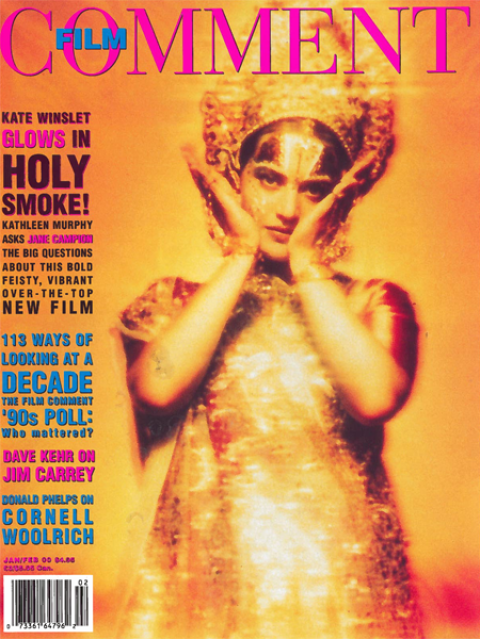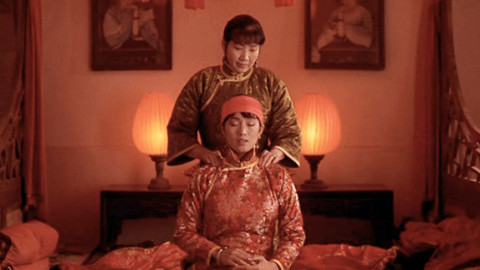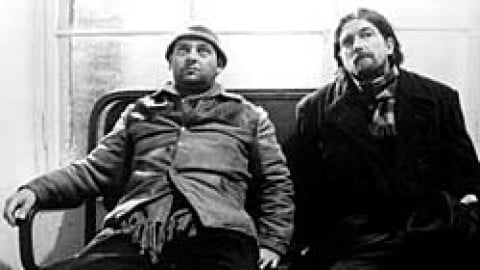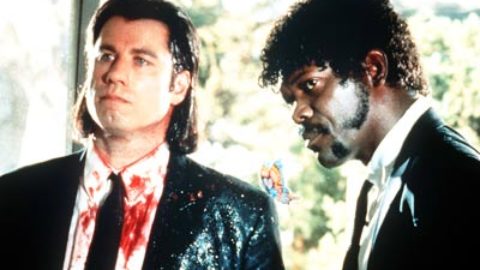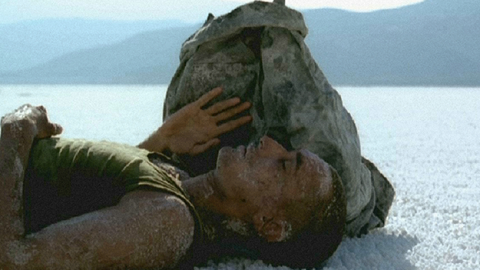This past fall, the editors, staff, and some friends of this magazine sent out letters to a blue-ribbon panel of critics, filmmakers, authors; archivists—people with a serious personal and professional investment in film -inviting their selections of the film of the decade and the film person of the decade. We weren’t necessarily after the “greatest” film, “most creative director,” or “brightest star.” Rather, we asked, “Zero in on the film of the Nineties, from any nation, that casts the longest shadow for you, whether in terms of excellence, power, visionary quality, symbolic importance, influence, or epically destructive badness—this is entirely your call. Same with the individual who, for better or worse, most decisively defines film in the Nineties. And we’d appreciate a brief statement why.” Additionally, we suggested that they send their lists of the Ten Best films of the decade, or the Ten Most Underrated. That part was optional, but as it turned out, most respondents gave it a whirl, and very provocatively, too.
PEGGY AHWESH filmmaker
The most evil, irredeemable, manipulative, award-winning piece of junk was Forrest Gump.
Craig Baldwin owned this decade of culture jamming. Conspiracy theories, media piracy, found footage recycling, alien autopsies, the Rapture, and time travel. Life on the fringe with the wackos.
Ten Best (chronological): Tales of the Forgotten Future (Klahr), Point Break (Bigelow), Tribulation 99: Alien Anomalies Under America (Craig Baldwin), Unforgiven, The Valley of Abraham (Oliveira), Spin (Brian Springer), When We Were Kings (Leon Gast); Happy Together and Ashes of Time (Wong Kar-wai); Genealogies of a Crime (Ruiz); Flat Is Beautiful, It Wasn’t Love, and Jollies (Sadie Benning)
JAMSHEED AKRAMI Iranian film scholar
Instead of a single film, I would like to select the entire Iranian cinema for the unprecedented and crucial role it played in defending the humanity of a much-maligned nation, and its generous offering of another cinema to the rest of the world.
Abbas Kiarostami—the person most responsible for bringing Iranian cinema to the attention of the world.
Ten Best (alphabetical): Breaking the Waves, The Crying Game, Fargo, The Hairdresser’s Husband (Leconte), La Belle Noiseuse (Rivette), Lamerica (Amelio), Leila (Dariush Mehrjui), Limbo (Sayles), Pulp Fiction, Taste of Cherry
PEDRO ALMODÓVAR filmmaker
Pulp Fiction—In spite of its massive success, Pulp Fiction is a very personal “film d’auteur,” in the best sense: the music, the dialogues, the plot, and the rhythm are used in a completely original way for the genre. Tarantino’s legitimate eclecticism is open to the worst imitations, but he can’t be blamed for that.
Roberto Benigni—With La Vita é bella Benigni undermines an insurmountable wall for European Cinema, or at least non-English-speaking cinema, and I don’t only mean its box-office success and omnipresence at the Oscars. Benigni sets a very interesting precedent for all of us who make films outside of America, proving that with the right support a foreign film can connect with the spirit of the American audience.
ANDREA ALSBERG UCLA Film & TV Archive
Orlando (Sally Potter)—A magnificent visual adaptation of Woolf’s masterpiece, which wraps up many of the gender/feminist concerns of the century with amazing style, grace, and Tilda Swinton’s face.
Martin Scorsese—Unparalleled cinematic visionary.
Ten Best: Orlando, The Blue-Veiled (Rakhshan Bani-Etemad), Pari (Mehrjui), Where Is the Friend’s Home? (Kiarostami), Crumb (Zwigoff), Boogie Nights, GoodFellas, Hard Boiled, Out of Sight
GEOFF ANDREW film editor, Time Out, London
Three Colors Trilogy—Kieslowski’s supreme mastery of his medium, coupled with his unsentimental humanity, not only ensures a complex but clear exploration of profound questions and expands the parameters of cinematic storytelling, but proves that the contemporary “art movie” need not be hermetic or old-hat.
Abbas Kiarostami—The sharpest yet most generous-spirited analyst of the relationship between life and film, and a great poet of the cinema who effortlessly demonstrates that simplicity need not be simplistic or superficial. Arguably the most persuasive riposte to the erroneous notion that Western cinema says it all.
Ten Best (in no particular order): The Three Colors Trilogy, Close-Up (Kiarostami), The Thin Red Line, Fargo, Nil by Mouth (Oldman); Take Care of Your Scarf, Tatjana (Kaurismäki); The Apostle (Duvall); Good Men, Good Women (Hou); From the Journals of Jean Seberg (Rappaport), Hana-Bi (Kitano)Heat (Mann)
JOHN ANDERSON film critic, Newsday
GoodFellas—because it’s funny, tragic, epic, personal, profoundly American, and seems as fresh now as the day it opened.
Scott Rudin—The Irving Thalberg of the Nineties, he’s amassed enormous influence, gotten a lot of sometimes difficult films made, and represents no particular aesthetic, style, or point of view. In this, he personifies the decade in film: his movies almost always possess a sense of class, and no corresponding danger of greatness.
Most Underrated: Safe (Haynes), Flowers of Shanghai, Crows (Kedzierzawska), Careful (Guy Maddin), Keep Cool (Zhang Yimou), Cyclo (Tran Anh Hung); Three Colors: White; Sick: The Life and Death of Bob Flanagan, Supermasochist (Kirby Dick); Lessons of Darkness (Herzog)
WES ANDERSON filmmaker
Reservoir Dogs—I think this must have been the biggest phenomenon of all time among movie fanatics, and it was definitely ripped off more than any other movie of the Nineties.
Peter Bogdanovich and Martin Scorsese (tie)—I carry a list with me to the videostore of movies to rent with titles introduced to me by these two directors and film historians in 1) the documentary and book A Personal Journey With Martin Scorsese Through American Movies and 2) Bogdanovich’s great collection of interviews and essays Who the Devil Made It.
Ten Best (no particular order): Flirting (Duigan); Olivier, Olivier (Holland); The Ice Storm (Ang Lee); The Daytrippers (Mottola), Little Odessa (James Gray), Buffalo ‘66 (Gallo), Bad Lieutenant (Ferrara), Un Monde Sans Pitié (Eric Rochant), Un Coeur en Hiver (Sautet), Jackie Brown
DAVID ANSEN film critic, Newsweek
Pulp Fiction—because it’s the ultimate postmodern movie; and because it has probably spawned more copycat/wannabe movies than any other.
Harvey Weinstein—For good and ill, he’s redrawn the map for independent and foreign films in the U.S.—not to mention the Oscars.
Ten Most Underrated: The Miracle (Jordan), Funny Bones (Chelsom), Babe: Pig in the City (Miller), State of Grace (Joanou), This Boy’s Life (Caton-Jones), Dead Man (Jarmusch), Baxter (Boivin), The Witches (Roeg), Miami Blues (Armitage), The Secret Garden (Holland)
JOSÉ CARLOS AVELLAR film critic, Brazil
Central do Brasil / Central Station by Walter Salles and Land and Freedom by Ken Loach—I cannot really explain why, but in my memory these two films are together as if they were one. Different stories, different styles. But maybe the same symbolic search for the father and the same kind of process of resensitization unite. And more than anything: both gave me real pleasure to the eyes.
Ken Loach—He made in the Nineties a very active cinema for and with the common worker: Hidden Agenda (90), Riff Raff (91), Raining Stones (93), Ladybird Ladybird (94), Land and Freedom (95), Carla’s Song (96, not so good in the second half but with a splendid beginning), and My Name Is Joe (98).
STEVEN BACH author
The English Patient (Anthony Minghella)—This is the one we will return to again and again for its complexity and character/narrative richness.
Steven Spielberg—for Schindler, Ryan, and (he said hopefully) DreamWorks and all it might imply or become.
MARY LEA BANDY Museum of Modern Art
A Perfect World—The Nineties will be remembered as a decade of new terrors for and by children. Clint Eastwood’s powerful if unhurried, morally ambiguous story of the escape of a convict and his young hostage hit the mark early, in 1993.
Babe—The orphaned porker that most improbably succeeds as a sheep-pig gave new meaning to the values of observation, perseverance, loyalty, and daring, if not artistic excellence. Babe is a hero for any age.
Ten Best / Most Underrated … a bit of either/or: A Perfect World, Babe, Dr. Akagi, GoodFellas, Histoire(s) du Cinéma, Pulp Fiction, Red, Sicilia! (Straub-Huillet), Thirteen (David Williams), Unforgiven
MICHAEL BARKER Sony Pictures Classics
A tie: Taste of Cherry (Abbas Kiarostami)—Coming out of the public screening in Cannes was like emerging from a deep, dark cave into the sunlight, noticing details of the physical world for the very first time. And: The Silence of the Lambs (Jonathan Demme)—As a longstanding member of the Academy, this is the only film nominated for Best Picture that I voted for and actually won.
Sean Penn—State of Grace, Carlito’s Way, Dead Man Walking, U-Turn, The Game, She’s So Lovely, The Thin Red Line, Hurlyburly, Loved, Sweet and Lowdown: Not since Brando in the Fifties has an actor so fully captured the consciousness of a decade.
Eleven Best Moviegoing Experiences (due to extreme prejudice, Sony Pictures Classics movies are exempt)—in the order seen: Miller’s Crossing, The Silence of the Lambs, One False Move, Ozu silent film series at the Film Forum, The Butcher Boy, Taste of Cherry, Live Flesh, Bulworth, The Thin Red Line, Max Ophüls retrospective at the Walter Reade Theater, American Beauty
DENNIS BARTOK American Cinematheque
Golden Balls / Huevos de Oro—Bigas Luna’s wildly oversized (and oversexed) 1993 comedy managed to offend everyone in sight, and still be one of the funniest, saddest, and most unforgiving portraits of the Nineties me-generation. Plus it had the best poster (designed by Luna himself): star Javier Bardem grabbing his cojones against a shimmering gold leaf background. Up yours, world!
James Cameron—for having ambition on the scale of a Griffith or von Stroheim. Anyone who saw the massive, haunting skeleton of the Titanic set sinking into solid ground in Rosarito, Mexico, knew that this was Cinema of the Extreme.
JEANINE BASINGER author/educator
Unforgiven—Clint Eastwood’s intelligent revision of Hollywood’s most American of genres gave new life to the form at the same time it completed its history. Eastwood’s daring critique of his own star persona inside the film just makes it all the more significant.
Martin Scorsese—During the Nineties, the first film school generation of directors came to maturity, led by the consistent quality of Scorsese’s work. His real contribution is that he turned the Nineties into the first decade of general respect for film preservation by lending the cause his considerable prestige, his passion and his knowledge. Scorsese’s commitment secured our heritage for the millennium and beyond. Runner-up: Steven Spielberg.
Most Underrated: A Midnight Clear (Keith Gordon), A Perfect World, Kundun, Lorenzo’s Oil (Miller), King of the Hill, Groundhog Day (Ramis), Ballad of Little Jo (Maggie Greenwald), Showgirls (P. Verhoeven), Funny Bones, Hoffa (DeVito), I Am Cuba (Kalatozov)
RAYMOND BELLOUR editor, Trafic
Level Five by Chris Marker—because it is the film that most decisively supports the passage between the past and the future of images, between the memory of cinema throughout the memory of history and a cinema to come that we do not know so much about.
Manoel de Oliveira—because as the oldest and as one the most inventive creators of forms in cinema present history, he is the one through whom the creation of cinema coincides in the closest way with the need for civilization.
Ten Best (my ten preferred) Films (without order of preference): Smoking/No Smoking (Resnais), Histoire(s) du Cinéma; Goodbye South, Goodbye (Hou), Sombre (Philippe Grandrieux), Dead Man, Man of the Story (Adoor Gopalakrishnan), Du jour au lendemain (Straub-Huillet), Caro Diario (Moretti), Su tutte le vette é pace (Yervant Gianikian et Angela Ricci-Lucchi), And Life Goes On (Kiarostami)
IRENE BIGNARDI film critic, La Republica, Italy
To Do Sobre Mi Madre (All About My Mother)—because it changes how we view family ties.
The Weinsteins—for better or worse, proposing a new aggressiveness in cinema.
IAN BIRNIE Los Angeles County Museum
Groundhog Day—Like its central character, this witty and successful early-Nineties film casts a long shadow across Pulp Fiction right up to Being John Malkovich. By demystifying and playing with story structure, it gave mainstream films in the Nineties a chance to be more innovative in presenting narrative and paved the way for the “special effects” comedy.
Lars von Trier—He made an epic film (Breaking the Waves) that addressed issues of spirituality and, in his adherence of the tenets of Dogma, opened unlimited possibilities for filmmakers in the digital age. Whether one accepts the aesthetic credo of Dogma is irrelevant—von Trier reaffirmed that cinema is an art and its aesthetics warrant serious attention.
Ten Most Underrated: Bitter Moon (Polanski), The Brandon Teena Story, Claire Dolan (Kerrigan), L’Enfer (Chabrol), Funny Games (Haneke), L’Humanité (Dumont), Living Out Loud (LaGravenese), Lost Highway, Madame Butterfly (Frédéric Mitterand film of opera), A Soldier’s Daughter Never Cries (Ivory)
STIG BJÖRKMAN critic/filmmaker, Sweden
Histoire(s) du Cinéma—At the start of the second centennial for the seventh art, a veteran like Jean-Luc Godard still proves that he is one of the most youthful and ingenious of filmmakers.
Lars von Trier—for his continuous and challenging exploration of the art of cinema. Few other filmmakers have as stubbornly and uncompromisingly tried to expand the borders for our vision.
Ten Most Underrated (as of today, the 18th of November…): The Grifters (Frears), Nouvelle Vague (Godard), Une Histoire du Vent (Ivens), The Sheltering Sky (Bertolucci), Caro Diario, 71 Fragments of a Chronology of Chance (Haneke), Liebestraum (Figgis); Good Men, Good Women; The Ice Storm, Le Vent de la Nuit (Garrel)
FRÉDÉRIC BONNAUD film critic, Les Inrockuptibles
Eyes Wide Shut—The century began with James Joyce’s Ulysses; it could only end with another reading of The Odyssey, Stanley Kubrick’s ultimate labyrinth.
Manoel de Oliveira—From No, or The Vain Glory of Command to La Lettre, Oliveira took cinema to its limits, to explore every aspect of a civilization and the images it produces, at the miraculous rhythm of one film per year.
Ten Best: Eyes Wide Shut, The Valley of Abraham, The Quince Tree Sun (Victor Erice), Sicilia!, Principio y Fin (Ripstein), Secret Défense (Rivette), Kids Return (Kitano), Le Complexe de Toulon (J-C Biette), Bad Lieutenant (Ferrara), Smoking/No Smoking
DAVID BORDWELL film theorist/author
An old-fashioned reply: the most deeply moving, most formally adventurous film I saw from the last ten years: Kiarostami’s Through the Olive Trees. With its tactile realism, rigorous concept, humor, brilliant exploitation of long takes /depth/ flatness / Kuleshov effect / closeups / longshots, and performances in which the flick of an eye carries everything, it shows that the power of the cinema at its best (that is, Ozu, Mizoguchi, Eisenstein, Sjöström, Feuillade, Dreyer, Hou, Renoir, Bresson, Ford, Lang, Tati) is undiminished.
In light of the above, Person of the Decade can only be Abbas Kiarostami, who seems along with his Iranian colleagues and the best Asian directors to be reinventing the history of the cinema, from early film tableaus through neorealism to reflexivity, without any postmodernist bad faith—instead, a spontaneous sense of human integrity.
Ten Best Nineties films I know (in no ranked order): Through the Olive Trees, A Brighter Summer Day (Yang), Chungking Express (Wong), The Blade (Tsui Hark), The Thin Red Line, Heat, Simple Men (Hartley), An Angel at My Table (Campion), A Scene at the Sea (Kitano), The Suspended Step of the Stork (Angelopoulos)
STAN BRAKHAGE filmmaker
These filmmakers have been most inspirational to me in the Nineties. Choose your favorite film by each.
poetic cinema: Peter Herwitz, Luther Price, Jen Reeves, Phil Solomon narrative-dramatic cinema: David Fincher, David Lynch, Martin Scorsese, Oliver Stone and John Cassavetes
DAVID BROWN film producer
Schindler’s List
Steven Spielberg, because of his dedication to film and storytelling.
TOM BRUEGGEMAN Loews Cineplex Entertainment
Ten Best: Three Colors: Bleu, Blanc, Rouge; Breaking the Waves, Taste of Cherry, Unforgiven, The Puppetmaster (Hou), Titanic, Crash, A Tale of Autumn (Rohmer), All About My Mother, In the Company of Men (LaBute)
Director of the decade: Krzysztof Kieslowski—In a decade that saw American domination in international market share (if not creativity), the best film is one that transcends national borders (France-Poland-Switzerland), combines traditional “art” cinema with a contemporary vision, and received international popular and critical acclaim (and even Oscar nominations), including in the depressingly cine-xenophobic U.S. That Kieslowski retired and then passed away after completing his final masterpiece leaves an aching void that puts a pall over the whole decade.
CHARLES BURNETT filmmaker
Mike Leigh’s Secrets and Lies—There is a quality of honesty and freshness that continues to resonate. Suspense and drama are the results of the simple unfolding of complex issues.
Ken Loach—His films and politics have been consistent.
NOËL CARROLL film theorist / author
Through the Olive Trees by Kiarostami. Matthew Barney—for his reinvention of the mythopoetic tradition of film in his own distinctive idiolect.
PAOLO CHERCHI-USAI George Eastman House
Blue (Derek Jarman, 1993)—a message on the ethics of vision.
Hou Hsiao-hsien—the messenger.
Ten Best (no particular order): God’s Comedy (Monteiro), Les Amants du Pont Neuf (Carax), Raise the Red Lantern (Zhang), The Puppetmaster, Exotica, Stairs I: Geneva (Greenaway), Through the Olive Trees, Bad Boy Bubby (De Heer), Lo Zio di Brooklyn (Ciprí & Maresco), Blue
PEGGY CHIAO film producer, film critic
The Puppetmaster (Hou)—for its aesthetic intention to blur the line between documentary realism and fiction realism, prompting viewers to contemplate the hermeneutic essence of cinema.
Director of the decade: Hou Hsiao-hsien
Most Underrated: The Puppetmaster, And Life Goes On, Laputa / Valley of the Wind (both Miyazaki); Good Men, Good Women; A Brighter Summer Day, In the Heat of the Sun (Jiang Wen), A Moment of Innocence, Bloody Morning (Li Xiao-hong), Police Story II (Jackie Chan); Chinese Odyssey, Part I and Part II (Jeff Lau)
IAN CHRISTIE author / critic / curator / educator
Film of the decade? Actually it’s just over two thousand films—the complete output of the Lumière brothers—reluctant pioneers of the cinema whose work was known only in scattered examples before the French Service des Archives and Association Frères Lumières got to work to locate and restore almost the entire catalogue, in time for the 1995-6 centenary. Anyone who saw even a fraction of that astonishing achievement will never forget the eerie sense of time-travel it conveyed: a world forever gone and yet forever preserved: the paradox of cinema, before cinema.
Aleksandr Sokurov, who has managed to survive the collapse of the USSR, which produced, nearly crushed, and then launched him as the hero of perestroika. But he survived to become the most audacious, tenacious, defiantly aesthetic and deeply political of all filmmakers at work in the world today—that’s really at work. And for the record, <em>Moloch is a masterpiece, worthy to set alongside Syberberg’s Hitler.
Someone else who should be remembered is Anatole Dauman, the great producer, who kept on doing what he’d always done right to the end: backing filmmakers such as Wenders, Ruiz, and Marker, against all commercial odds.
Underrated (in order of release): The Asthenic Syndrome (Muratova), La Double Vie de Véronique (Kieslowski), Whispering Pages (Sokurov), Arizona Dreams (Kusturica), Fate (Fred Kelemen), Casino, The Life Story of David Lloyd George (Elvey, made 1919, released 1996), Trois Vies et Une Seule Mort (Ruiz), Robinson in Space (Patrick Keiller), Fear and Loathing in Las Vegas (Gilliam)
MICHEL CIMENT editor, Positif
Van Gogh (Maurice Pialat)—for the quality of its light, its restrained emotion, its portrayal of a society and of an artist’s relation to it.
Hou Hsiao-hsien and Abbas Kiarostami—for their emergence as leading filmmakers, their experiments in narrative structure, and the scope of their inspiration.
Ten Best (alphabetical): Edward Scissorhands, Eyes Wide Shut, Flowers of Shanghai, Miller’s Crossing, Naked, Smoking/No Smoking, Through the Olive Trees, Ulysses’ Gaze, Underground, Valley of Abraham
CHARLES COLEMAN Facets Cinematheque
Sátántangó—It is with this epic masterpiece that Hungarian filmmaker Béla Tarr is able to brilliantly evoke the messianic fervor brought about by post-communist despair and the underlying tension of the quixotic quest for happiness. It is through the character of the Outsider (actually a former police infomer), who promises to lead the residents of a small country village to the promised land, that Tarr ambitiously exposes the personal need for self-deception and millennial anticipointment, factors which define the algebra of need for the decade of the Nineties.
Jim Carrey—This protean performer is the most engaging and challenging actor of the decade. He is able to transform himself in numerous roles that have encompassed the range from the guilty pleasure of Dumb and Dumber, the underrated Cable Guy to the Orwellian dystopic effort The Truman Show. His thespian skills reflect the creative anxiety of our technological New Age, and he represents our ever-shifting coping mechanisms that will hopefully grapple with our uncertain future.
Ten Best: The Puppetmaster, A Scene at the Sea (Kitano), Lamerica, Brigands: Chapter VII (Iosseliani), To Sleep With Anger (Burnett); Trois Couleurs: Blue, White Red; Underground, The Blue Kite (Tian Zhuangzhuang), Valley of Abraham, M/Other (Nobuhiro Suwa)
RICHARD COMBS film critic / lecturer
A Moment of Innocence (Mohsen Makhmalbaf)—for the scene of the Tehran tailor rhapsodizing about John Ford and the final Heartstopping freeze frame of hieratic vérité: moments that prove the truism about film being a universal language, and the truism that films are best when their concerns are local, and prove them both nonsense.
Robert Altman—The man who had never been away came back with the sneaky The Player, a film-about-Hollywood that wasn’t, shrewdly followed it with Short Cuts, a jamboree (like Nashville) for those who like jamborees, then quietly went on producing masterpieces until Cookie’s Fortune, a film of quiet sublimity.
In alphabetical order, a combination of personal favorites and the outrageously underrated: Bram Stoker’s Dracula (Coppola), Close-Up, Irma Vep (Assayas), Kansas City (Altman), The Last of the Mohicans (Mann), Looking for Richard (Pacino), A Moment of Innocence, Same Old Song (Resnais), The Secret Agent (Hampton), True Crime (Eastwood)
KAREN COOPER Film Forum
The Cremaster series by Matthew Barney—The first four films in Barney’s five-film opus suggest a world in which gender, history, and landscape are highly mutable, sexually charged, and breathtakingly beautiful.
Lars von Trier—The eccentric, Dogma-wielding Danish writer-director has changed the rules and will undoubtedly continue to do so right into the next millennium.
Most Underrated Films—I would prefer “Most Unknown Films of Great Significance”: Holland-based, Peru-born Heddy Honigmann makes humanist documentaries of uncommon intelligence and wit: The Underground Orchestra, on musicmaking political refugees in Paris, and O Amor Natural, on the erotic poems of the Brazilian Carlos Drummond de Andrade, are two of many.



